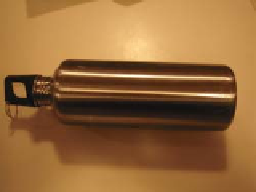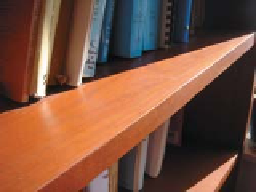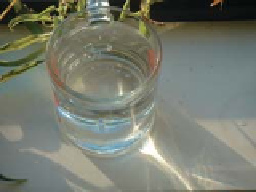Graphics Reference
In-Depth Information
invisible from every point on the light source, in which case it's in the
umbra,
or
it may be visible from just
some
of the points of the luminaire, in which case it's
in the
penumbra,
or it may be visible to all points of the source, in which case
it's not shadowed at all. To be more precise: A point
P
is in the penumbra if the
set of points of the luminaire,
L
, visible from
P
when the occluder is removed, is
different from the visible set when the occluder is present. Thus, if
L
is a typical
incandescent lightbulb, we don't require that every point of the bulb be visible
from
P
(which never happens), but only that every point that
could
be visible
from
P
actually
is
visible.
The next important phenomenon is
boundaries
such as the contours dis-
cussed in Chapter 5. Boundaries between objects, between materials in a single
object, etc., are all significant. (Indeed, shadow edges are yet another example of
boundaries.)
Figure
29.9:
Diffraction
under
more diffuse lighting.
Many surface properties are revealed through reflection of light. Under point
illumination, diffractive objects like the surface of the CD in Figure 29.8 clearly
reveal their reflectance structure; under area luminaires, the reflection is less
focused but still shows the characteristic rainbow pattern (see Figure 29.9). Less
extreme than diffraction are the stretched-out highlights that appear on brushed-
metal surfaces (see Figure 29.10); the alignment of the brush marks generates
these in much the same way that ripples on a pond generate an extruded reflection
of moonlight.
And of course, for more common scattering functions, phenomena like
edge highlights, generated by very glossy materials with high curvature (see
Figure 29.11), are commonplace.
Polarization phenomena are less obvious in general, although anyone who has
worn polarized sunglasses knows that mirror-reflected light tends to be somewhat
polarized, and therefore can be attenuated by the polarizing lens in the sunglasses.
Caustics
(see Figure 29.12) are bright areas that arise from the focusing of
illumination by curved surfaces, through either reflection or refraction. Typically
they are produced by point sources or small area sources like the sun. Figure 29.13
shows how caustics weaken or disappear under more diffuse illumination.
Assuming for the moment that most caustics arise from sunlight, that is,
from light arriving on essentially parallel rays, caustics will, in general, appear
close to the curved surfaces that cause them. Figure 29.12 suggests the reason: You
can see several rays meeting at a bright spot, but beyond that spot, the rays diverge.
Since caustics depend on convergence, once you are sufficiently distant from a
surface (roughly, the maximum radius of curvature of the surface) the caustics can
no longer appear. By studying the
focal points
of a surface (places at which nearby
normal rays meet), you can determine how likely a surface is to cast a caustic on
some distant object under random parallel illumination.
There's a dual phenomenon to caustics: Eye rays meeting a curved surface
may converge on a single point, or a small range of points. A magnifying glass is
designed to take advantage of this phenomenon, for instance, but it also appears
in less intentional settings. For instance, the reflections of the blue windows in
Figure 29.14 appear somewhat wavy and distorted because of the curvature of the
windows in which they're reflected.
Transmission of light through transparent media also generates
refractive
phe-
nomena, like the offset in the top and bottom parts of the red pen in Figure 29.15.
Because spatial continuity (things that are straight should appear straight, things
in a regular pattern should appear regular, etc.) is easily noticed, its interruption
by refraction is perceptually significant.
Figure 29.10: Brushed metal gen-
erates stretched-out highlights.
Figure 29.11: The bright line
along the edge of the bookshelf
results from the glossy reflection
of sunlight.
Figure 29.12: Caustics cast by a
glass of water in sunlight.










